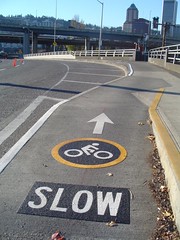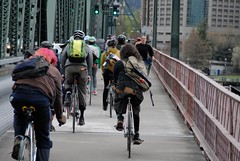Since last Thursday, readers have left nearly 500 comments on our stories about a horrific crash on the Hawthorne Bridge between two bike riders.
The discussion has revolved around who’s at fault, the design of the sidewalk/path (it’s still unclear what it is, technically), how people should behave while crossing the bridge, and so on.
My thoughts and coverage instantly focused on the design issues. I wanted to hash out all the possible, infrastructure-based solutions and I thought this crash was yet another sign that our bike/ped network was falling behind and quickly becoming inadequate. I thought this high-profile crash was the perfect illustration that bikes need more space. Now!
But so far, no infrastructure solution seems to be in the cards. The County’s hope is that the new Morrison Bridge bike/ped facility will help alleviate some traffic. On the Hawthorne, they’ve said no to a railing, there are no plans to widen the existing path, and putting bikes on the outside lane of the main roadway is pretty close to a non-starter.
I’m not saying we should stop putting pressure on policymakers and planners; they still want and need our ideas and constructive criticisms to make our transportation infrastructure work for everyone. But now it’s seems clearer than ever that we need to work on our mental infrastructure as well.
I’m one of those people who loves to ride in part because of the independence it allows. When riding, I don’t feel bound by the same constraints as when I drive (and yes, I do own a car — a minivan actually). I can stop whenever I feel like it to take in a view, grab a phone call, or chat with a friend. I can ride up on the sidewalk if I want (as long as I’m not downtown, where it’s illegal). When an intersection is backed up with cars, I can zoom right by them in the shoulder or bike lane, grinning at my good fortune.
I was also raised to see bike riding as more of a competitive pursuit judged by speed, rather than as a utilitarian mode of transport judged by purpose and function. I have begun to shed that baggage, but it still hangs around.
Those things, combined with always running late to another interview or event, and I’ve begun to expect that the bikeway system in Portland should allow me to go as fast as I need to go at all times.
It dawned on me a few days ago, how different I am when I drive. When I’m on the freeway or a street that suddenly becomes congested, I don’t swing over into the emergency lane, honk my horn a few times, and zoom by everyone. No. I put my foot on the brake and slow down.
Some folks out there ride like they should never be forced to slow down. Others feel like their bike bell, once dinged a few times, gives them a free pass to fly by (often mere inches from someone else), and still others will speed by without any audible warning at all (that’s a recipe for disaster if you ask me).
So, I hate to admit it, but those of us who ride in bike traffic should maybe start becoming more like car drivers. When the lane gets crowded, slow down, don’t make any sudden turns, and just chill out. If you still want/need to pass a slower rider, do it politely; leave plenty of space, make sure they are aware of your presence, then consider a wave, a smile, or even a “hello” as you roll by.
After the events of this past week, I think I’ll re-read City of Portland bike coordinator Roger Geller’s editorial from last month. Geller called on all of us to ride with both courtesy and confidence and I think he was on to something.
Geller wrote that, “Because our infrastructure hasn’t yet caught up with the growing demands on it, it’s imperative that we do all we can to share well.” He also added that, “behaving in an exemplary manner will help attract more people to bicycling.”
It’s hard to disagree with that.
What do you think? Has the Hawthorne Bridge incident changed your thinking?
— Read all our coverage of this story here.



